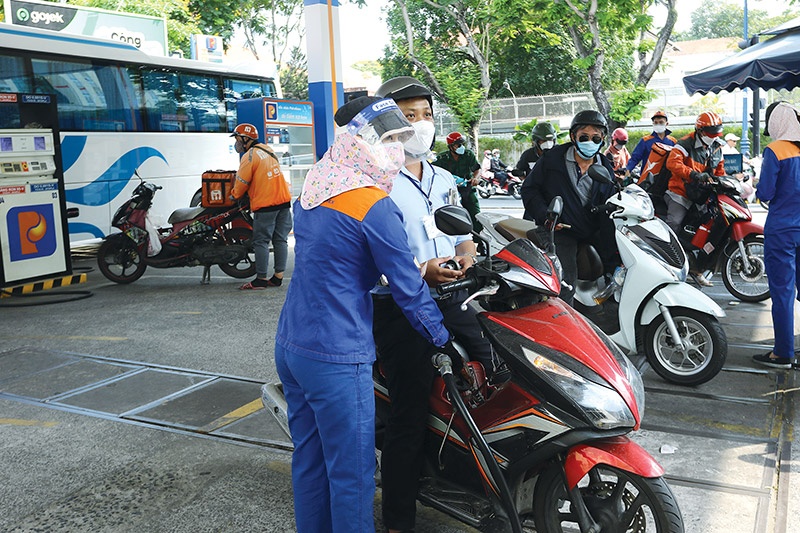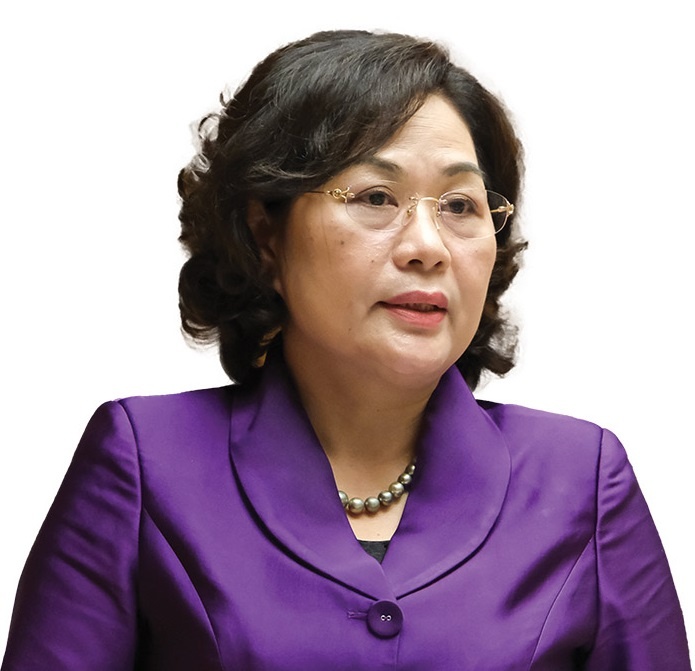Global fuel concerns force tax action
 |
| Petrol in Vietnam is nearly one-third more expensive than it was at the start of the year, Photo: Le Toan |
The Ministry of Industry and Trade (MoIT) said that if there are continued hikes in petrol prices, which is occurring worldwide, it will continue working with the Ministry of Finance (MoF) to use a number of solutions to control them.
“The MoIT will combine with other ministries and sectors to ask the government to direct the MoF to continue reviewing and using other tools such as taxes and fees in order to stabilise fuel prices, including the consideration of a reduction in the import tax and special consumption tax in the structure of fuel prices,” stated an MoIT report on Vietnam’s trade and industrial development situation released over a week ago.
The average price of petrol has increased by about 30 per cent from the beginning of 2022 and over 50 per cent on-year in the domestic market.
After being raised seven times in a row since late April, the price of E5 RON 92 petrol was last week revised down by the MoIT and the MoF to $1.34 per litre, and that of RON 95 petrol to $1.42. RON 95 has become all the more popular in the market, accounting for 70 per cent of total petrol consumed in Vietnam. Meanwhile, diesel increased by 1.7 US cents to $1.29.
According to Deputy Minister of Finance Ta Anh Tuan, to stabilise fuel prices and minimise the negative effects of the petrol price increases, the MoF has recommended that the government and the National Assembly Standing Committee reduce some kinds of tax imposed on gasoline products.
The MoF has submitted proposals to the National Assembly (NA) and the government to reduce the environmental protection tax (EPT) rate by 50 per cent for jet fuel, gasoline (except ethanol), diesel oil and lubricants, and by 70 per cent for kerosene. This reduction will reduce domestic oil and petrol prices by 3.3-9.5 US cents per litre, depending on each product.
“However, after the tax reduction, world fuel prices may continue on the uptrend. Therefore, the MoF now proposes to further cut the EPT tax to the floor level for gasoline, oil, and grease products,” Tuan said.
Nguyen Bich Lam, former general director of the General Statistics Office (GSO), said in the structure of petrol and oil prices, each litre sold in the market embraces several taxes: VAT of 10 per cent, special consumption tax of 10 per cent, and also the EPT tax. “Moreover, each litre of petrol also covers some types of costs. It is calculated that total taxes and fees account for 44 per cent of the selling price of each litre of RON95 petrol,” Lam said. “The NA and the government impose these taxes and fees on fuel in order to create revenue for the state budget and regulate the use of this type of goods effectively. If the taxes are removed, the state budget will be affected.”
The government has already halved the EPT tax on petrol, along with varying cuts on the same tax for other fuel types, from April 1 until the end of 2022. It also reduced the VAT rate, also applicable to retail fuel, from 10 to 8 per cent in January.
Nguyen Hoai Nam, deputy general secretary of the Vietnam Association of Seafood Exporters and Producers, told VIR that the spiralling hike in fuel prices has increased costs for the fishery sector.
“For example, tens of thousands of fishing vessels have suffered a 20-30 per cent rise in operational costs including fuel, ice, freshwater, and foodstuffs. The total cost for each trip offshore for each vessel is about $13,000. Thus, the increase in fuel prices has led to total costs of nearly $17,000 per ship,” Nam said. “Many vessels have had to halt operations as a result.”
| The economic recovery remains strong despite heightened global uncertainties related to the protracted war in Ukraine, higher commodity prices, supply chain disruption caused by health-related lockdowns in China, and tightening global financial conditions. Nevertheless, the authorities should be vigilant about inflation risks associated with rising prices of fuels and imports, which may dampen the ongoing recovery of domestic demand. Temporary support including targeted transfers should be considered to help poor households weather the surging fuel prices. As the price shock is mainly affecting fuel and transportation costs, targeted temporary subsidies for main gasoline and fuel users (such as truckers) could also be considered to alleviate hardship and blunt the inflationary pressures. Also, the government could incentivise investment to help increase aggregate supply. Incentivising alternative energy production and use would reduce the economy’s dependence on imported fuels and promote greener growth.Source: World Bank |
Moreover, the fuel price hike has also led to a big climb in transportation costs of 15-20 per cent, Nam added. “Since 2020, this type of cost from Vietnam to Florida has increased from $4,000 to $18,000 in Q1 2022 and down to $16,400 per container in June. If the taxes and fees for fuel are reduced, it would be great news for enterprises,” Nam said.
The MoIT has revealed that the total demand for petrol and lubricant oil in Vietnam this year is about 20.6 million cubic metres or 5.2 million cu.m for each quarter. In Q2, it is estimated that the supply is about 7.2 million cu.m – including 3.2 million cu.m domestically produced, 2.5 million cu.m imported, and 1.5 million cu.m in stock from Q1.
This supply will sufficiently meet demand for Q2, with about two million cu.m in stock able to be transferred to Q3.
The GSO last week reported that the consumer price (CPI) index for June increased 0.69 per cent on-month, 3.18 per cent against last December, and 3.37 per cent on-year. The on-year CPI climbed 2.96 per cent for Q2 and 2.44 per cent for the six months.
“In the first half of the year, the price of fuel has been adjusted 16 times, causing an average on-year soar of 51.83 per cent in the price of petrol and this has led to a 1.87 per cent rise in CPI,” the GSO said in a report. “The price of gas in the first six months expanded 25.92 per cent on-year, resulting in a 0.38 per cent in CPI increase. Also, the price of building materials rose 7.95 per cent on-year due to a rise in prices of steel cement, and sand – causing an ascension of 0.16 per cent in CPI.”
| Nguyen Thi Hong, Governor State Bank of Vietnam
Governments and central banks around the world are implementing solutions to control inflation. For Vietnam, the economy is very open, and especially imports as a percentage of GDP account for about 100 per cent, meaning that domestic production is highly dependent on the import of raw materials from the world. Thus, the country is also facing pressure from inflation. At present, the government is strongly directing ministries, agencies, and sectors to closely coordinate both monetary and fiscal policies. In the first half of the year, our inflation has been kept at a controllable level of 2.44 per cent. But through thorough analysis and evaluation, we find that this price largely increases due to an expansion in the price of world goods. From an operating perspective, the packages in the Socioeconomic Recovery and Development Programme have not been disbursed, so when these solutions are implemented, they will also affect inflation. Therefore, from now to the end of the year, monetary policy will also have to closely follow the monetary and macroeconomic developments as well as the disbursement progress of these packages to come up with appropriate management measures. Monetary policy is by nature a short-term one, and especially in inflation control, it is very important to combine monetary and fiscal policies, and price control policies. Currently, we have a price management steering committee, through which the government is directing ministries, agencies, and sectors to closely analyse the movements and causes of inflation to come up with the right actions. |
What the stars mean:
★ Poor ★ ★ Promising ★★★ Good ★★★★ Very good ★★★★★ Exceptional
 Tag:
Tag:
Related Contents
Latest News
More News
- Tax sector wraps up 2025 and sets priorities for next year (December 25, 2025 | 14:00)
- A tipping point for digital and hybrid wealth management in Vietnam (December 23, 2025 | 13:33)
- $250 million deal targets women-owned SMEs, sustainable agriculture (December 22, 2025 | 17:40)
- Stock market posts resilient 2025 performance (December 19, 2025 | 18:17)
- Citi Vietnam receives 2025 AmCham CSR recognition (December 19, 2025 | 16:35)
- As global green supply chain reshapes, will Vietnam be left behind? (December 19, 2025 | 08:00)
- Banks gear up for massive capital increases (December 18, 2025 | 17:04)
- Securing capital and efficiency for Vietnam’s 2026-2030 growth ambitions (December 17, 2025 | 10:00)
- Energy sector in need of blended finance mechanisms (December 17, 2025 | 09:00)
- Vietnam still has room to mobilise capital for sustainable growth (December 17, 2025 | 08:57)
























 Mobile Version
Mobile Version